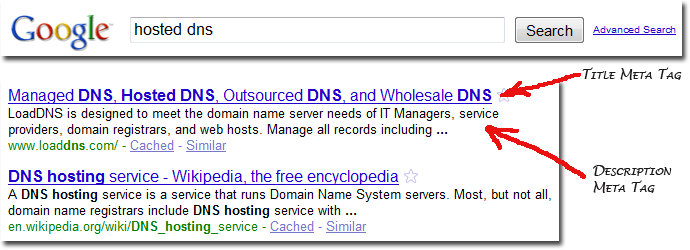You have a lot of control over how your web pages appear in search results. Optimizing a page’s title tag, description meta tag, and the look and structure of the URL can go a long way towards improving its presentation in the search results. This helps visitors make more informed decisions about the results they click on. Also, a more descriptive title tag and URL naming structure can help the search engine understand the content of the page better.
Title and Description Meta Tags
Using descriptive words and phrases in your page’s title tag helps both users and search engines better understand the focus of the page.
Here are some basic rules on properly crafting the title tag:
Use the space provided – Most major search engines display approximately 60 characters from a page’s title tag in the title of a search result. These 60 characters are an opportunity to tell both users and search engines what the focus of the page is. There’s no need to go past this many characters, as most search engines will display ellipses ( … ) after this limit. Also, search engines may give less weight to words after a certain point.
Give the search engine important clues about the page – Imagine that the text in the title tag is the only signal that a search engine has to figure out what a page is about. Would your title tag do a good job if this were the case? The product name is great to have in the title tag; however, it’s good to include other important information like what the product does, who it targets, or what its main features are.
Know about the “NOODP” meta tag – If your site is listed in the Open Directory Project, Google may choose to use information listed there in the title and snippet of your main page’s result. When this occurs, it may be a signal that your page is missing its title or description meta tag, or both. To prevent this behavior, webmasters can make use of the “NOODP” meta tag.
Give the visitor important clues about the page – For users discovering your products through search results, it’s important that each product puts its best foot forward with descriptive title tags (shown in the title of the result) and description meta tags (sometimes shown in the snippet). In the result above, if a user is unfamiliar with hosted dns services, for example, he or she can quickly understand what the product does after reading the result’s title and snippet. Shout out to folks at LoadDNS.com – providers of hosted DNS services for doing a great job with title and description meta tags that helped them attain a valuable top organic position in the search results!
Remember that some users only look at titles – Each user reads a search results page in a slightly different way. Some look at all parts of the result, others look more at the snippet, and some only look at titles. If you skimp on your title tag, you’re missing out on clicks from users who only scan result titles on a search results page.
For more in-depth and detailed analysis of your search engine readiness and site optimization requirements, retaining an SEO consulting firm can lead to increased search engine visibility and consequently ROI.

